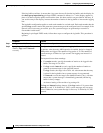
22-5
Catalyst 2960 and 2960-S Switch Software Configuration Guide
OL-8603-09
Chapter 22 Configuring IGMP Snooping and MVR
Understanding IGMP Snooping
Figure 22-2 Second Host Joining a Multicast Group
Leaving a Multicast Group
The router sends periodic multicast general queries, and the switch forwards these queries through all
ports in the VLAN. Interested hosts respond to the queries. If at least one host in the VLAN wishes to
receive multicast traffic, the router continues forwarding the multicast traffic to the VLAN. The switch
forwards multicast group traffic only to those hosts listed in the forwarding table for that IP multicast
group maintained by IGMP snooping.
When hosts want to leave a multicast group, they can silently leave, or they can send a leave message.
When the switch receives a leave message from a host, it sends a group-specific query to learn if any
other devices connected to that interface are interested in traffic for the specific multicast group. The
switch then updates the forwarding table for that MAC group so that only those hosts interested in
receiving multicast traffic for the group are listed in the forwarding table. If the router receives no reports
from a VLAN, it removes the group for the VLAN from its IGMP cache.
Immediate Leave
Immediate Leave is only supported on IGMP Version 2 hosts.
The switch uses IGMP snooping Immediate Leave to remove from the forwarding table an interface that
sends a leave message without the switch sending group-specific queries to the interface. The VLAN
interface is pruned from the multicast tree for the multicast group specified in the original leave message.
Immediate Leave ensures optimal bandwidth management for all hosts on a switched network, even
when multiple multicast groups are simultaneously in use.
Table 22-2 Updated IGMP Snooping Forwarding Table
Destination Address Type of Packet Ports
224.1.2.3 IGMP 1, 2, 5
Forwarding
table
CPU
Host 1 Host 2 Host 3 Host 4
Router A
PFC
VLAN
1
0
234 5
45751


















